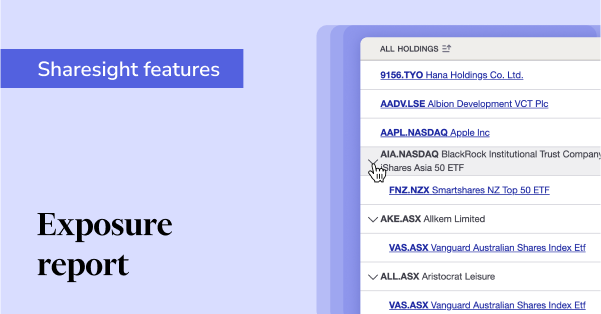Open Banking changes in Australia
An area that we’re particularly passionate about at Sharesight is your access and control over personal financial data, which is why we’ve been involved as a member of Fintech Australia’s Open Data Working Group in the Australian Government’s Open Banking Review.
We welcome the recent Australian Government decision to create a regulated system that will allow Australians to unlock their own financial data, and provide more choice over financial products and services while enabling a more competitive marketplace.
The Australian government has accepted the timeframe proposed by the Farrell report into Open Banking, which will see the first phase of the open banking reforms introduced within the next 12 months. The three phases will progressively unlock consumer access to data, with:
- Bank transaction and deposit accounts, plus debit and credit card data, available by July 2019
- Mortgage data available by February 2020
- Remaining financial products recommended by the review made available by July 2020
Our hope is that this last phase will make it easier for Australian investors to import their brokerage and investment accounts into Sharesight where their broker does not already support the Sharesight API.
Sharesight CEO Doug Morris sees this as an exciting move: “Obviously Sharesight is concerned with things like brokerage and investment accounts, but starting with the big retail product like transaction accounts is the best, first move for all parties and ought to get the ball rolling on the others, which is what we have seen in the UK.”
Still confused about Open Banking? Let us break down what it means.
What is Open Banking?
Open Banking is a concept that refers to banks and financial institutions making data available back to consumers via secure, widely accepted technologies.
Open Banking promises increased access and control over personal financial data, and delivers increased choice and more competitive financial products and services. A basic example is a lender who could offer more competitive loans based on your banking history, versus a one-size-fits-all bank approach. You, the consumer, would authenticate the connection between the bank and your lender, who could then offer you a more competitive rate.

Why Open Banking matters
We’re passionate about Open Banking because we devote significant development resources to making it as easy as possible for investors to get their data into Sharesight -- which is made next to impossible by financial institutions who have done their best to lock up that data.
With Open Banking changes coming into effect, we’re excited for investors (and fintechs) over the coming years, with the promise of new data aggregation tools, portfolio analysis, investment ideas, tax efficiencies, and cost savings to come.
FURTHER READING
- Government Response to the Open Banking Review
- Consumer Data Right
- Why Australia needs Open Banking like the UK
- Wrap-up of the 2017 British Australian Fintech Forum
- Open banking framework to drive customer choice and innovation across Australia
- Where Sharesight fits in FinTech Australia’s ecosystem map

See what’s inside your ETFs with Sharesight’s exposure report
See inside your ETFs and get the full picture of your investment portfolio's composition with Sharesight's exposure report.

How KmacD Financial streamlines reporting and saves time with Sharesight
We talk to financial planning firm KmacD Financial about how the Sharesight-AdviserLogic integration helps them save time and streamline client reporting.

Sharesight product updates – November 2023
The focus over the past month has been on implementing additional feature ideas relating to our new (beta) exposure report.